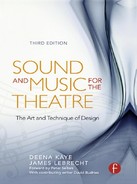Preface to the First Edition
At our first meeting in 1984, both of us felt that we had finally met someone who spoke the same language of sound and music for the stage. Deena was approaching theatre with strengths as a musician, musical director, and composer; Jim had expertise in operating, engineering, and producing the designs and compositions. Although each of us came to the field from different disciplines, we were amazed to find we had so many experiences in common. Our artistic values and attitudes were very similar. Collaborating on our first show (A Touch of the Poet at the Berkeley Repertory Theatre), we lamented that there was no resource that offered an aesthetic and practical approach to designing sound and music for the stage. Our collaboration on this book seemed a natural way to remedy this situation.
Collectively, we had much experience in producing effects, training sound operators, and managing limited budgets. We were well-versed in the practical elements needed to design sound for the stage. What we thought was needed was not yet another book about the technical aspects of sound—good books along those lines already existed—but rather a book that would explore the artistic intents, needs, and skills of the sound designer.
This book is for designers who desire both a greater knowledge about the aesthetics of their work as well as a practical approach to the design process. We hope to motivate aspiring designers to new dimensions of their creativity. Sound and Music for the Theatre is also for composers who wish to incorporate their expertise and artistry into stage productions; for sound operators and technicians who are asked to be designers; and for community theatres that wish to elevate the quality of their productions by including this long-ignored textural element. Directors or sound technicians looking for methods of organizing and applying sound to a production may also find our experiences useful. However, we are not presenting detailed explanations of electronics or specifics on scoring or composing. We also do not focus on musicals, and for this reason, do not explore sound reinforcement in detail.
The reality of working in the theatre is that one production may make many resources available to the sound designer, while another may provide few or none. Consequently, we have presented ways of working from the most rudimentary, bare-bones situations to the most complex, sophisticated ones. Either way, you’ll find that there are techniques to use in any situation to maintain a high level of artistry and assure the integrity of your work.
Ultimately, the stature of the sound designer will be acknowledged to a greater extent by directors, producers, and general managers. Budgetary considerations will not always be an obstacle. We hope that sound design in theatre will continue to develop as an accepted and essential design element.
Deena Kaye
James LeBrecht
April 1992
